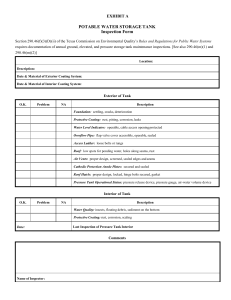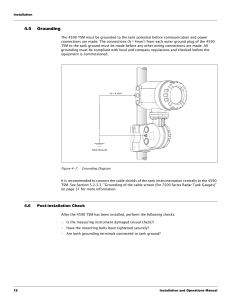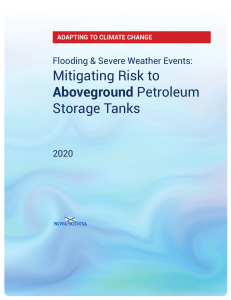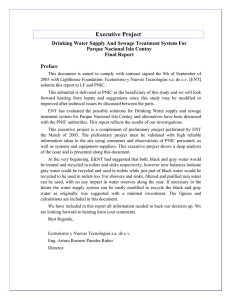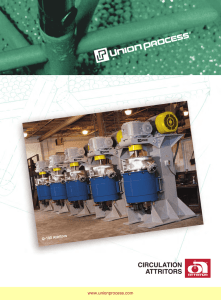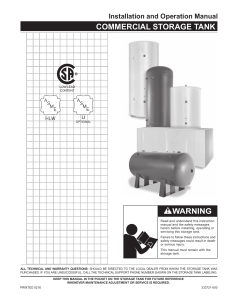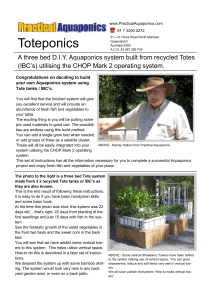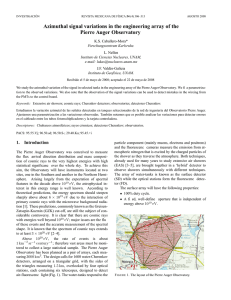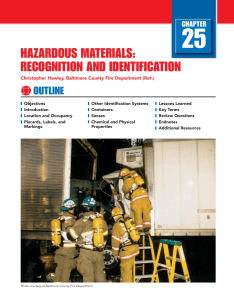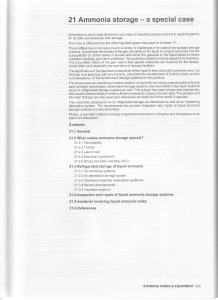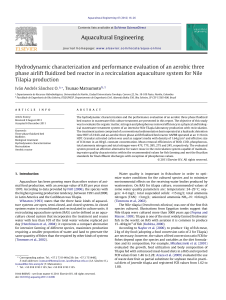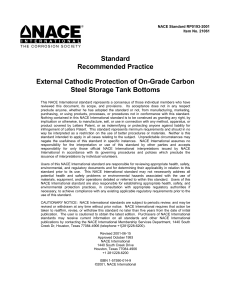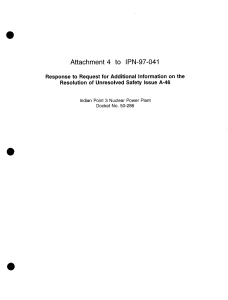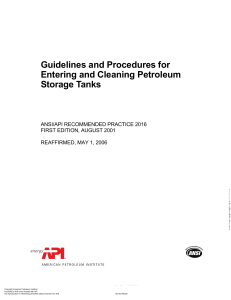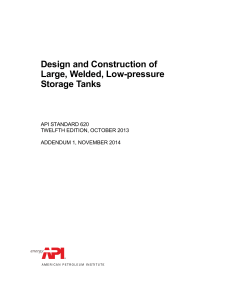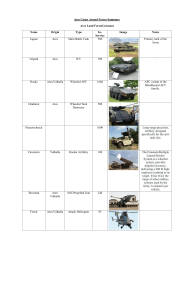Explosion at a Hazardous Waste Site Caused by
Anuncio
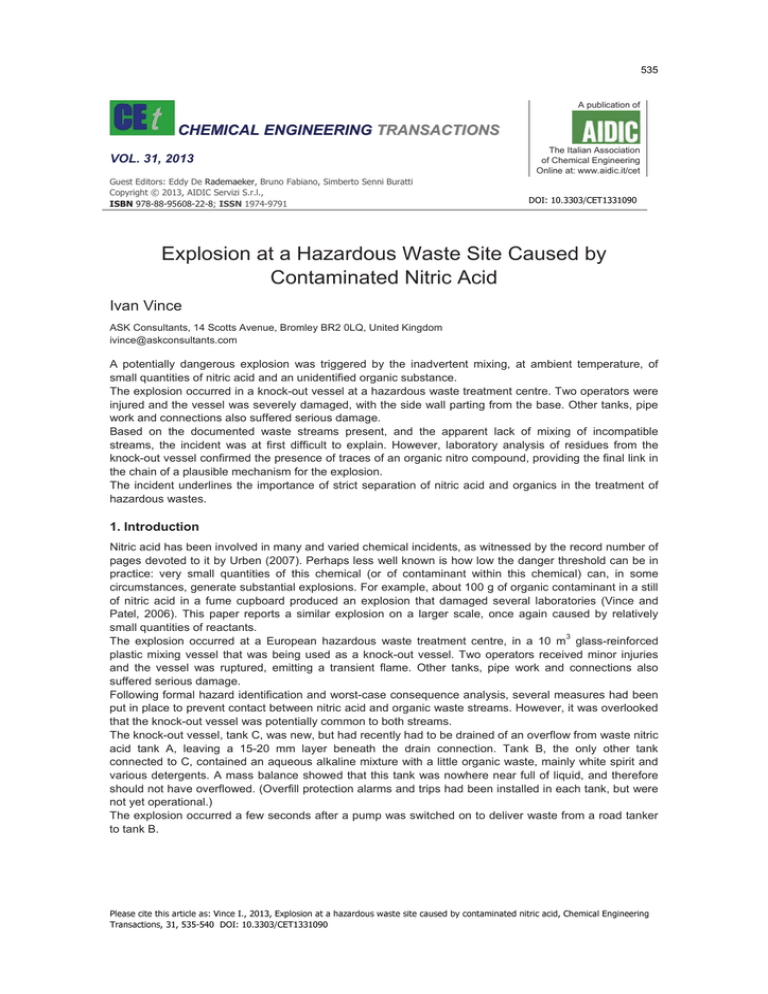
535 A publication of CHEMICAL ENGINEERING TRANSACTIONS VOL. 31, 2013 The Italian Association of Chemical Engineering Online at: www.aidic.it/cet Guest Editors: Eddy De Rademaeker, Bruno Fabiano, Simberto Senni Buratti Copyright © 2013, AIDIC Servizi S.r.l., ISBN 978-88-95608-22-8; ISSN 1974-9791 Explosion at a Hazardous Waste Site Caused by Contaminated Nitric Acid Ivan Vince ASK Consultants, 14 Scotts Avenue, Bromley BR2 0LQ, United Kingdom [email protected] A potentially dangerous explosion was triggered by the inadvertent mixing, at ambient temperature, of small quantities of nitric acid and an unidentified organic substance. The explosion occurred in a knock-out vessel at a hazardous waste treatment centre. Two operators were injured and the vessel was severely damaged, with the side wall parting from the base. Other tanks, pipe work and connections also suffered serious damage. Based on the documented waste streams present, and the apparent lack of mixing of incompatible streams, the incident was at first difficult to explain. However, laboratory analysis of residues from the knock-out vessel confirmed the presence of traces of an organic nitro compound, providing the final link in the chain of a plausible mechanism for the explosion. The incident underlines the importance of strict separation of nitric acid and organics in the treatment of hazardous wastes. 1. Introduction Nitric acid has been involved in many and varied chemical incidents, as witnessed by the record number of pages devoted to it by Urben (2007). Perhaps less well known is how low the danger threshold can be in practice: very small quantities of this chemical (or of contaminant within this chemical) can, in some circumstances, generate substantial explosions. For example, about 100 g of organic contaminant in a still of nitric acid in a fume cupboard produced an explosion that damaged several laboratories (Vince and Patel, 2006). This paper reports a similar explosion on a larger scale, once again caused by relatively small quantities of reactants. 3 The explosion occurred at a European hazardous waste treatment centre, in a 10 m glass-reinforced plastic mixing vessel that was being used as a knock-out vessel. Two operators received minor injuries and the vessel was ruptured, emitting a transient flame. Other tanks, pipe work and connections also suffered serious damage. Following formal hazard identification and worst-case consequence analysis, several measures had been put in place to prevent contact between nitric acid and organic waste streams. However, it was overlooked that the knock-out vessel was potentially common to both streams. The knock-out vessel, tank C, was new, but had recently had to be drained of an overflow from waste nitric acid tank A, leaving a 15-20 mm layer beneath the drain connection. Tank B, the only other tank connected to C, contained an aqueous alkaline mixture with a little organic waste, mainly white spirit and various detergents. A mass balance showed that this tank was nowhere near full of liquid, and therefore should not have overflowed. (Overfill protection alarms and trips had been installed in each tank, but were not yet operational.) The explosion occurred a few seconds after a pump was switched on to deliver waste from a road tanker to tank B. 536 2. Investigation The attending inspector from the national industrial safety authority concluded on the spot that the event was a hydrogen explosion, hydrogen having been generated by the action of the nitric acid overflow on steel skimmer blades in tank C. However, there were several obvious flaws in the reasoning that led to this conclusion, not least the unfulfilled requirement for a substantial amount of iron to have dissolved in order to generate a flammable hydrogen atmosphere in tank C – in fact, the skimmer remained virtually intact. 2.1 Sampling and initial analysis Liquid samples were taken from each tank, as well as a scraping of the charred material adhering under the roof of tank C. Initially, the following items were measured/analysed in each liquid sample: - pH - C/H/N - VOCs in headspace - over 30 metal ions On the day of the incident, there had been an off-site odour complaint of hydrogen sulphide (H2S); however, this odour was not detected on site. The lower flammability limit of H2S in air is many orders of magnitude greater than its odour threshold. Since tank C was not sealed (a pipe had been removed from the roof, leaving a 7.5 cm opening), a flammable mixture of H2S inside it should have been readily detected by many people on site. It is true that a high concentration of H2S paralyses the olfactory nerves, preventing people from detecting the smell; however, the gas is rapidly and strongly toxic at such concentrations and there were no reports of toxic effects. Nevertheless, as uncontrolled combustion of H2S, due to incomplete mixing with air, would produce some elemental sulphur, an attempt was made to detect sulphur (gravimetrically by extracting with toluene and absorbing onto copper) in the tank C samples. None was detected, either in the liquid or the charred solid (or visually on the inside surfaces of tank C). 2.2 Initial results Analysis of the liquid samples broadly confirmed the documented inventories of tanks A and B contents; in particular, that tank A contained no organic material (i.e. no detectable carbon). Surprisingly, in view of the acid overflow from tank A and the relatively low liquid level in tank B, the tank C residue was found to be alkaline, with pH = 10.8; the pH of the tank B sample was 11.1. The tank B and tank C samples both had a distinct odour of white spirit. However, GCMS headspace analysis revealed important differences. The concentration of volatile organics was far higher in the tank C liquid than in tank B. More significantly, there was a shift in the distribution of individual components in the ‘white spirit’ in going from tank B to tank C, such that the latter corresponded to a more volatile liquid than the former – see Figure 1 below. The comparison of concentrations of various metal ions among the samples was inconclusive as to the relative contributions of tanks A and B to the residue in tank C. Many of the metal concentrations were below the limit of detection in one or more of the samples, and several others were close to the limit, where measurement error becomes important. 2.3 Further analysis The listed organics in tank B would not have reacted with nitric acid; indeed, a nitric acid/white spirit mixture is used safely as a chemical reagent. However, since the contents of tanks A and B clearly had come into contact in tank C shortly before the incident, further analysis was undertaken of the liquid samples from tanks B and C, to look for organic species that would react with nitric acid, and for products of such reactions. Unfortunately, most of the samples had been disposed of before further analysis could be carried out. However, in a tank C liquid sample, FTIR spectroscopy revealed a very small but distinct pair of bands in the region characteristic of nitrotoluenes and other nitroaromatics. 537 Figure 1: GCMS analysis of hydrocarbon components of organic layers from tanks B and C, showing ‘centre of gravity’ of peaks further to the left (increasing volatility) in the latter. 3. Discussion 3.1 Likely mechanism of the explosion The following discussion is illustrated by Figures 2-4 below. While the average concentration of nitric acid in tank A was approximately 12 %, the last two IBCs emptied into it had contained approximately 50 % nitric acid. Further, there is a strong possibility that the mixer in the tank was not running. Therefore, as depicted in Figure 2, the acid overflow from tank A is likely to have been much more concentrated than that of the tank inventory as a whole. This is significant because, while even 12 % nitric acid is a strong oxidising agent, the concentrated acid would have been capable of reacting, in the time available, with a far wider range of organic substances. Although, as already mentioned, tank B is unlikely to have overflowed, conditions in the tank during recirculation (the tank B mixer was inoperative) favoured the generation of foam, which would readily have diffused into tank C (see Figure 3). Foaming, caused by splash filling and recirculation, would have been enhanced by the presence of detergents. Foam would not have been detected by the radar level gauge. Charging further liquid into tank B would have immediately displaced an equivalent volume of foam directly into tank C (Figure 4). Finally and significantly, unlike liquid overflow, foam carryover is consistent with the observed increase in volatility of the hydrocarbon fraction in going from tank B to tank C, noted above. The flash point of white spirit is in the approximate range 38-60 °C (Babrauskas, 2003). Therefore, the flash point of the more volatile, ‘distilled’ white spirit arriving in tank C may well have been exceeded at the ambient temperature. Alternatively, the substance could have been raised above its flash point by an 538 exothermic reaction involving nitric acid itself (possibly but not necessarily neutralisation) or its unstable organic reaction product. The presence of trace nitrotoluene derivatives in tank C indicates that reaction did take place between the nitric acid overflow from tank A and aromatic(s) gradually carried over in foam from tank B. A plausible sequence of events is as follows. Besides the nitroaromatics detected, it appears likely that other, less stable nitro or nitrate compounds were formed at the same time. The tank was then drained. When pumping commenced from the road tanker into tank B, enough caustic foam would have been displaced into tank C to neutralise the acid residue, generating a substantial amount of heat, which could have been the trigger for an exothermic reaction, such as the decomposition of the unstable compound(s). The release of energy from this decomposition could have occurred explosively and/or it could have served to ignite the white spirit distillate vapour in the vessel. 3.2 Lessons learned A recent review of 364 accidents in the chemical process industries (Kidam et al, 2010) found that no less than 10% were at least partly caused by contamination of a process stream; and that a root cause Figure 2: situation after draining nitric acid in tank C resulting from tank A overflow; note that residue in tank C is likely to have been concentrated – up to 50% nitric acid. common to most of these was an insufficient hazard analysis during process development and plant design. In the present instance, the operator had identified the potential hazards of allowing nitric acid to come into contact with organic wastes, and accordingly had ensured that there were dedicated vessels and pipework for each liquid stream. However, the operator had overlooked the possibility of airborne transfer of foam laden with organic material into the common knock-out vessel. The recommissioned unit has a separate knock-out vessel for nitric acid. The accident would almost certainly have been prevented by the overfill protection alarms and trips, had these been operational. (It might well have been prevented even without these if the tank B mixer had been operational, eliminating the need for recirculation.) A root cause for the dangerous decision to run the unit without the benefit of the installed protection systems was, again, found to be deficient process hazard analysis. 539 Figure 3: foam generated in tank B by splash filling and recirculation has migrated into tank C and come into contact with the nitric acid residue. 4. Conclusions An explosion resulting in injuries and severe plant damage occurred as a result of contact between a small quantity of nitric acid and a presumably still smaller quantity of some incompletely characterized organic substance(s). A combination of inappropriate and inoperative equipment, together with the use of a knockout vessel common to both streams, allowed the substances to come into contact in an unanticipated manner. The accident once again underlines the need to store and handle the common chemical nitric acid with uncommon respect Figure 4: fresh material pumped into tank B displaces a relatively large volume of foam, whose caustic component neutralises the acid residue and raises the temperature in tank C. 540 References Babrauskas V., 2003, Ignition Handbook, Fire Science Publishers, Issaquah, USA. Kidam K., Hurme M., Hassim M.H., 2010, Technical analysis of accident in chemical process industry and lessons learnt, Chemical Engineering Transactions, 19, 451-456. th Urben P., Ed., 2007, Bretherick’s Handbook of Reactive Chemical Hazards, 7 ed, Elsevier, Oxford, UK. Vince I., Patel M., 2006, Explosion in fume cupboard damages several laboratories, Loss Prevention Bulletin 187, 6-8.
